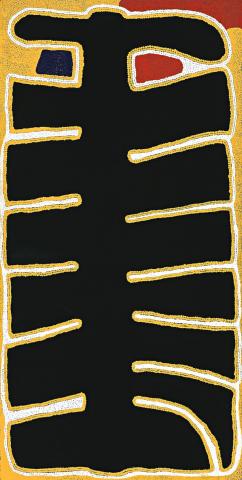TRAVELS OF THE GOANNA MEN IN THE ARTIST'S COUNTRY, 1990
MURTIYARRU SUNFLY TJAMPITJIN
synthetic polymer paint on canvas
120.0 x 60.0 cm
inscribed verso: artist's name and Warlayirti Artists cat. 556/90
Warlayirti Artists, Balgo Hills
Gallery Gabrielle Pizzi, Melbourne
Private collection, Melbourne
Innovation and Tradition: Exhibition of Recent paintings by Warlayirti Artists from Balgo Hills WA, Gallery Gabrielle Pizzi, Melbourne, November 1990 (label attached verso)
Crossroads – Towards a New Reality: Aboriginal Art from Australia, The National Museum of Art, Kyoto, 22 September – 8 November 1992; The National Museum of Art, Tokyo, 17 November – 20 December 1992, cat. 74 (label attached verso)
Uchiyama, T., (ed.), Crossroads – Towards a New Reality: Aboriginal Art from Australia, The National Museum of Modern Art, Kyoto, 1992, p. 106 (illus.)
Encircled by the plains of the Tanami and Great Sandy Deserts, and located at the intersection of major Dreaming tracks linking the Western Desert and the Kimberley regions, Wirrimanu (Balgo Hills) in Western Australia is a place of great religious significance and the ceremonial hub for several Indigenous clans. This importance as a religious place was magnified when a Catholic Pallottine Mission was established there in 1939. The uniqueness of the community is in part a result of the diversity of its members. Culturally varied, the traditions of seven language groups have resulted in a social and creative pluralism unlike any other desert location, with the exception perhaps of Papunya in the early 1970s.
It was from this extraordinary meld that the first decade (from 1981 to 1992) of the Balgo painting movement emerged, in part, heralded by the land rights movement of the previous decade.1 Functioning as documents which asserted their custodianship of major ceremonies and tracts of land, the 'genius of Wirrimanu art emerged in all its bold opulence: a broad calligraphic style combined with linear techniques of dotting and lush surfaces, together evoking depths of land and being ... Often appearing more as a collection of individual or family renditions of Tjurrkupa (Dreaming), Wirrimanu's 'style' is one of conjunction, experimentation and expressiveness.'2
The landmark exhibition, Art from the Great Sandy Desert, held in 1986 at the Art Gallery of Western Australia, resulted in the art from Balgo being recognised as a distinct body of work, distinguished by its diversity of style and bold use of colour. It was in this context that the work of Sunfly Tjampitjin flourished. Developing a complex language for the translation of traditional designs onto canvas, he was considered one of the region's major contemporary artists. Bold in form, his paintings have a sense of the monumental in scale, even though the dimensions of a work may not be large. These forms dominate the picture plane and convey notions of faith and authority.
Travels of the Goanna Men in the Artist's Country, 1990 is an iconic painting within the artist's short career. The Wati Kutjarra Tjukurpa, or Two Goanna Men Story, is immensely significant for a number of Aboriginal clans and underpins the ritual education that turns boys into men. In their ancestral journeys, the Two Goanna Men travelled over a large expanse of desert country including that of the Warlpiri, Pintupi, Kukatja, Walmajarri and Ngardi peoples. On their travels, the two men moved in and out of the ground at various places, creating natural phenomena, drinking from rockholes and soakages and leaving traces of their presence in the landforms. The artist's outstation at Yagga Yagga, located 80 kilometres south of Balgo in the Great Sandy Desert, is the site of a major sequence of this story. Centred around Yagga Yagga, this episode of the story involves cultural activities such as teaching about the use of fire and the preparation and cooking of various foods. Sunfly's work is classic in its minimalist perfection, balancing large icons with fine detail to create monumental effects within moderately sized canvases. It is measured, and restrained, and imparts an unfailing atmosphere of authority.
1. The Kimberley Land Council, which serviced the Wirrimanu area, was formed in 1978 (see McDonald, H., Blood, Bones and Spirit: Aboriginal Christianity in an East Kimberley Town, Melbourne University Press, Melbourne, 2002, p. 89
2. Watson, C., in Perkins, H., One Sun, One Moon, Aboriginal Art in Australia, Art Gallery of New South Wales, Sydney, 2007, p. 219
CRISPIN GUTTERIDGE
